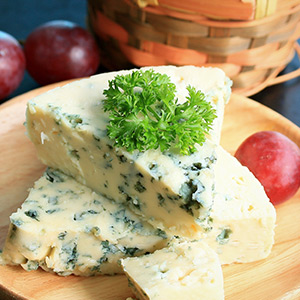Blue Cheese (Veined Cheese)

These flavourful cheeses are popular with connoisseurs yet still relatively unfamiliar to many people. Though they do not constitute a separate cheese family, veined cheeses are well represented in the soft-curd, semi-firm curd and firm-curd cheese families.
Blue cheeses are named for the blue and green veins running through their curd. The process used to make them is similar to that of other cheeses. The main difference is that they are seeded with penicillium roqueforti, microscopic mushroom cultures. These cultures give blue cheeses their distinctive taste and veins.
What do cheesemongers do?
Ripening is done in a cellar and lasts between 7 weeks and 9 months. Cheesemongers use long needles to pierce the cheese and allow air to enter, which facilitates the development of mould and the even spread of blue and green veins through the curd. Blue cheeses can be made with cow’s, goat’s or sheep’s milk.
Characteristics:
The white curd is compact, smooth in consistency and has blue and green veins running through it. The natural rind is grey because it has not been washed. The middle of the cheese is softer and milder tasting. With aging, the flavour becomes saltier and varies from mild to spicy. Should any moisture form on the surface, the rind must be brushed before the cheese is served.
Know about knives:
Because mould develops on contact with air, it is recommended to use a different knife to serve blue cheese to avoid contamination with other cheeses.

Varieties
- Soft curd: Gorgonzola, Bleu de Bresse, Bleubry, Cambozola
- Semi-firm curd: Roquefort, Bleu d’Auvergne, Bleu Bénédictin, l’Ermite, Ciel de Charlevoix, Geai bleu
- Firm curd: Stilton, Fourme d’Ambert, Rosenborg
Purchasing tips
Look for veined cheeses with bright colours and a firm, creamy texture. Avoid products with an ammonia odour and a dry, crumbly texture.
How to best appreciate them

Veined cheeses are usually served at the end of a meal, with crackers or bread and a robust wine or Port. The unusual and distinctive taste of veined cheese will please those who enjoy sharper flavours.
A little tip to help the uninitiated acquire a taste for blue cheese is to mix it with cream cheese and use it as stuffing for meat, with fruit or vegetables and for a dip. Blue cheese is also delicious in hamburgers, on grilled meat and as a garnish for onion soup.
Storage
In their original packages, blue cheeses can be stored in the warmest part of the refrigerator for a few weeks to three months, depending on variety. Once opened, replace the packaging regularly with aluminium foil.
Freezing
Depending on the ripening method used, veined cheeses are classified in the soft-curd, semi-firm or firm-curd family of cheeses. Ask METRO’s cheese experts to find out more about each cheese family and for more information on how to freeze them.
Have you tried Fourme d’Ambert?
One of the mildest blue cheeses, Fourme d’Ambert is AOC (Appellation D’origine Contrôlée) accredited and comes from the Auvergne and Rhône-Alpes regions. Made with cow’s milk, the curd is firm and veined with moulds. This is accomplished by seeding the curd with blue mould before injecting air to accelerate the development of micro-organisms. The natural rind is grey with yellow and orange flecks.
Veined curds
| Fat content | Varies according to the cheese family (refer to label) |
| Moisture content | Varies according to the cheese family (refer to label) |
| Storage | Wrap in aluminium foil. Can be stored for 2 to 5 weeks. |
| Upon purchase | Look for bright colour. Flavours of mushroom, cream or alcohol. Firm and creamy texture. |
| Upon purchase | Avoid a matte, grey or pink colour. Ammonia odour. Dry and crumbly texture. |










